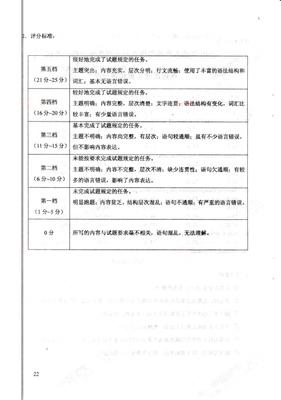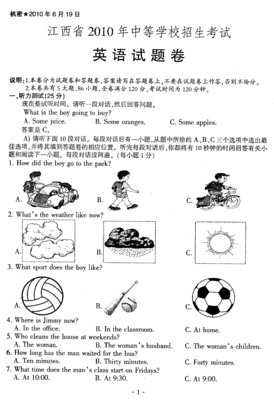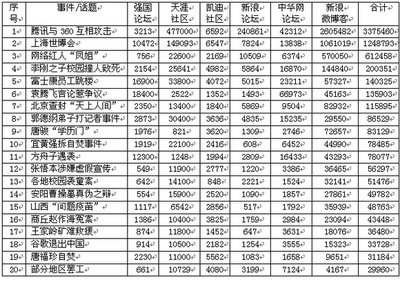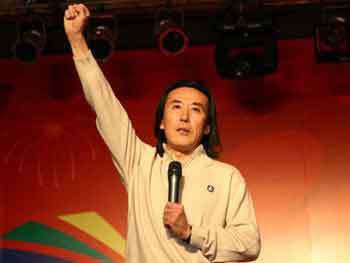几年来,全国研究生入学考试作为国家选拔培养高一级人才的考试系统,已经进行了数次改革,从多项选择题的取消、写作提醒的调整、阅读体型的改变到总体难度的调整,最后到考试时间的调整和阅卷方式的改革,都可以看出国家对研究生入学考试的重视程度和研究生考试所具有的“与时俱进”的特点,这些在英语试题题干上面,体现得虽然没有政治那么明显,但也是十分显现的,足以引起考生的重视。随着国家提出“科技兴国、科技兴教”的战略,国家各个部门的觉悟,都与日俱增,从近年来英语试卷的题材和内容,就可见一斑。近年来,突然出现“亲子鉴定”、“心理学”、“社会学”、“历史”、“经济”、“法律”等方面的题材和内容,而且难度也有逐年增加的趋势。与去年相比,2010年英语考试较2009年偏难,特别体现在完形填空、新题型两个方面,下面我们按照考研入学试卷的结构,从内容来源到材料类型进行详细的剖析。
2010年全国研究生入学考试英语试题的完形填空题摘自《经济学家》(TheEconomist)【注:近年中国有将这一期刊翻译成《经济学人》,是一种翻译不当造成的,已有学者就此专门撰文,故不赘述。】2009年6月4日的“财政与经济学”栏目(Finance andEconomics)。这次考试中,出题者只用了《经济学家》的原文的第一、二、四段,摘了最后一段的最后一句的主句,将第三段进行摘要式改写,结果就产生了这次考试的Use ofEnglish。为了便于参考,我将全文引录如下:
Questioning the Hawthorneeffect
Light work
Jun 4th 2009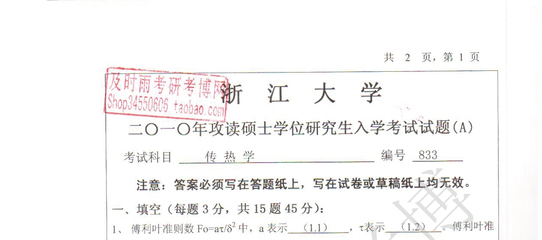
From The Economist print edition
Being watched may not affect behaviour,after all
WHEN America’s NationalResearch Council sent two engineers to supervise a series ofindustrial experiments at a large telephone-parts factory calledthe Hawthorne Plant near Chicago in 1924, it hoped they would learnhow shop-floor lighting (1)affectedworkers’productivity. Instead, the studies ended(2) upgiving their name to the “Hawthorneeffect”, the extremely influential idea that thevery(3) actof being experimented upon changessubjects’behaviour.
The idea arose because ofthe (4)perplexing behaviour of the women who assembled relays and woundcoils of wire in the Hawthorne plant. According to(5)accounts of the experiments, their hourly output rose whenlighting was increased, but also when it was dimmed. It didnot(6) matter what was done; (7)so longas something was changed, productivity rose.An (8)awareness that they were being experimented upon seemed tobe (9)enough to alter workers’ behaviour (10)by itself.
The data from the illuminationexperiments had never been rigorously analysed and were believedlost. But Steven Levitt and John List, two economists at theUniversity of Chicago, discovered that the data had survived thedecades in two archives in Milwaukee and Boston, and decidedto (11)subject 【本段采取了摘要式改写,正确答案应该是过去时态】them toeconometric analysis. The Hawthorne experiments had anothersurprise in store for them. (12)Contraryto the descriptions in the literature, they found nosystematic (13)evidence that levels of productivity in thefactory rose whenever changes in lighting wereimplemented.
It turns out thatidiosyncrasies in the way the experiments were conducted may haveled to (14)misleading interpretations of what happened.(15)Forexample, lighting was always changed on a Sunday, when the plantwas closed. When it reopened on Monday, output(16)duly rose compared with Saturday, the last working day beforethe change, and (17)continued to rise for the next couple of days.(18)But a comparison with data for weeks when there was noexperimentation showed that output always went up on Mondays.Workers (19)tended to beaver away for the first few days of the working weekin any case, before (20)hitting a plateau and then slackeningoff.
Another of the original observations wasthat output fell when the trials ceased, suggesting that the act ofexperimentation caused increased productivity. But experimentationstopped in the summer, and it turns out from the records ofproduction after the experiments that output tended to fall in thesummer anyway. Perhaps workers were justhot.
There is a suggestion in the data thatproductivity was more responsive to changes in artificial thannatural light. This could be interpreted as a subtler version ofthe Hawthorne effect, if you believe that workers were aware thatchanges in artificial light were induced by the experimenters,whereas natural light was changing on its own. But even thisevidence is weak. For something so influential and intuitivelyappealing, it turns out that the Hawthorne effect is remarkablyhard to pin down.
(http://www.economist.com/businessfinance/displayStory.cfm?story_id=13788427&source=login_payBarrier)
为了方便,也为了准确地给出参考答案,更为了考生摸索出题人的出题线索,我采用直接在原文中用下划线配红色标出参考答案,不方便处,还望各位谅解。
阅读题第一篇文章属于文化范畴,摘自《大英在线百科全书》2007年11月由TerryTeachout写的The Amateur asCritic,是探讨美国艺术、文化评论和新闻报道没落的,是以1917到1975年的《曼彻斯特卫报》为讨论素材的,后经出题者删减编排成试卷阅读文章。为参考方便,现将原文引录如下:
The Amateur as Ctritic
Commentary, November 2007 by TerryTeachout
Summary:
This article discusses the decline of arts andcultural reviews and reporting in newspapers in the United States.The author focuses on the British classical music critic for the"Manchester Guardian" newspaper from 1917-1975 Neville Cardus. Theauthor also discusses Cardus's autobiography and the issue of whyhe has not gotten more attention as a critic.
Excerpt fromArticle:
OF ALL THE changesthat have taken place in English-language newspapers during thepast quarter-century, perhaps the most far-reaching has been theinexorable decline in the scope and seriousness of their artscoverage. Not only have many newspapers done away with theirbook-review sections, but several major papers, including theChicago Sun-Times and the Minneapolis Star-Tribune, no longeremploy full-time classical-music critics. Even those papers thatcontinue to review fine-arts events are devoting less space tothem, while the "think pieces" on cultural subjects that oncegraced the pages of big-city Sunday papers are becoming a thing ofthe past.
It is, I suspect,difficult to the point of impossibility for the average readerunder the age of forty to imagine a time when high-quality artscriticism could be found in most big-city newspapers. Yet aconsiderable number of the most significant collections ofcriticism published in the 20th century, including Virgil Thomson'sThe Musical Scene (1945), Edwin Denby's Looking at the Dance(1949), Kenneth Tynan's Curtains (1961), and Hilton Kramer's TheAge of the Avant-Garde (1973) consisted in large part of newspaperreviews. To read such books today is to marvel at the fact thattheir erudite contents were once deemed suitable for publication ingeneral-circulation dailies.
We are even fartherremoved from the discursive newspaper reviews published in Englandbetween the turn of the 20th century and the eve of World War II,at a time when newsprint was dirt-cheap and stylish arts criticismwas considered an ornament to the publications in which itappeared. In those far-off days, it was taken for granted that thecritics of major papers would write in detail and at length aboutthe events they covered.[*] Theirs was a serious business, and eventhose reviewers who wore their learning lightly, like GeorgeBernard Shaw and Ernest Newman, could be trusted to know what theywere about. These men (for they were all men) believed injournalism as a calling, and were proud to be published in thedaily press. "So few authors have brains enough or literary giftenough to keep their own end up in journalism," Newman wrote, "thatI am tempted to define 'journalism' as 'a term of contempt appliedby writers who are not read to writers who are.'"
Why, then, arevirtually all of these critics forgotten? Neville Cardus, who wrotefor the Manchester Guardian from 1917 until shortly before hisdeath in 1975, is now known solely as a writer of essays on thegame of cricket. During his lifetime, though, he was also one ofEngland's foremost classical-music critics, a stylist so widelyadmired that his Autobiography (1947) became a best-seller. He wasknighted in 1967, the first music critic to be so honored. Yet onlyone of his books is now in print, and his vast body of writings onmusic is unknown save to specialists. How is it possible that socelebrated a critic should have slipped into near-totalobscurity?
(http://www.britannica.com/bps/additionalcontent/18/27218535/The-Amateur-as-Critic)
阅读题第二篇文章属于法律范畴,选自《商业周刊》2008年2月21日“法律纵横”或曰“法务”栏目(Legal Affairs)的一篇由Michael Orey署名的文章,题目为A Pending Threat to Patents: A case beforean appeals court could make it harder to win legal protection forbusinessmethods,是从法律角度探讨支付方式专利权的。现全文引录如下,以便参考使用(http://www.businessweek.com/magazine/content/08_09/b4073068471067.htm?chan=magazine+channel_what's+next):
A Pending Threat toPatents
A case before an appeals court could makeit harder to win legal protection for businessmethods
by Michael Orey
Over the pastdecade, thousands of patents have been granted for what are calledbusiness methods. Amazon.com (AMZN) received one for its"one-click" online payment system. Merrill Lynch (MER) got legalprotection for an asset allocation strategy. One inventor patenteda technique for lifting a box.
Now thenation's top patent court appears poised to scale back onbusiness-method patents, which have been controversial ever sincethey were first authorized 10 years ago. In a move that hasintellectual-property lawyers abuzz, the U.S. Court of Appeals forthe Federal Circuit on Feb. 15 said it would use a case pendingbefore it to conduct a broad review of business-method patents. InreBilski, as the case is known, is "a very big deal,"says Dennis D. Crouch, a patent professor at the University ofMissouri School of Law. It "has the potential to eliminate anentire class of patents."
EXPLOSION INFILINGS
Curbs onbusiness-method claims would be a dramatic about-face, because itwas the Federal Circuit itself that ushered in such patents withits 1998 decision in the so-called State Street Bank (STT) case,approving a patent on a way of pooling mutual-fund assets. Thatruling produced an explosion in business-method patent filings,initially by nascent Internet companies trying to stake outexclusive rights to specific types of online transactions. Later,more established companies raced to add such patents to theirportfolios, if only as a defensive move against rivals that mightbeat them to the punch. In 2005, IBM noted in a court filing thatit had been issued more than 300 business-method patents, despitethe fact that it questioned the legal basis for granting them.Similarly, some Wall Street investment firms armed themselves withpatents for financial products, even as they took positions incourt cases opposing the practice.
The Bilski caseinvolves a claimed patent on a method for hedging risk in theenergy market. The Federal Circuit issued an unusual order statingthat the case would be heard by all 12 of the court's judges,rather than a typical panel of three, and that one issue it wantsto evaluate is whether it should "reconsider" its State Street Bankruling.
The FederalCircuit's action comes in the wake of a series of recent decisionsby the Supreme Court that has narrowed the scope of protections forpatent holders. Last April, for example, the justices signaled thattoo many patents were being upheld for "inventions" that areobvious. The judges on the Federal Circuit are "reacting to theanti-patent trend at the Supreme Court," says Harold C. Wegner, apatent attorney and professor at George Washington University LawSchool.
Orey covers corporations for BusinessWeek.
第三篇文章属于社会学范畴,摘自《哈佛商业评论》(Harvard Business Review)2007年2月,题为The AccidentalInfluentials,是哥伦比亚大学纽约分部社会学教授Duncan.J.Watts对MalcolmAladuell的专著The TippingPoint的书评。在书评中,邓肯教授主张名人影响效力是偶然形成的,真正有实质性影响的是普通人。对此,他于同年与Vermont大学数学兼统计学助理教授Peter Sheridan Dodds合写Influentials, Networks, and Public OpinionFormation,发表于《消费者研究》第34卷。
本文只是这篇哈佛评论文章的前五段,确切地说,是第五段第四行之前。出题人对这部分引文,进行了改、换、替等的工作,比如将一段中的actions改成acting等。对此,我认为,这样的改换没有任何意义,除非是知识产权法层面上的意义。邓肯教授的全文不到两页,如果对全文感兴趣,可点击下面的链接:http://business.twoday.net/static/foehrenbergkreis/files/20070216HBR_Accidental.pdf
为了对比起见,兹将邓肯教授文章的被引用部分,引录如下:
The AccidentalInfluentials
In his best-sellingbook The Tipping Point,Malcolm Gladwellargues that “social epidemics” are driven in large part by theactions of a tiny minority of special individuals, often callinfluentials, who are unusually informed, persuasive, or wellconnected. The idea is intuitively compelling --- we think we seeit happening all the time --- but it doesn’t explain how ideasactually spread.
The supposed importance of influentialsderives from a plausible-sounding but largely untested theorycalled the “two step flow of communication”:Information flows from the media to the influentials and from themto everyone else. Marketers have embraced the two-step flow becauseit suggests that if they can just find and influence theinfluentials, those select people will do most of the work forthem. The theory also seems to explainthe sudden and unexpectedpopularity of certain looks, brands, or neighborhoods. In many suchcases, a cursory search for causes finds that some small group ofpeople was wearing, promoting, or developing whatever it is beforeanyone else paid attention. Anecdotal evidence of this kind fitsnicely with the idea that only certain special people can drivetrends.
In recent work, however, my colleaguePeter Dodds and I have found that influentials have far less impacton social epidemics than is generally supposed. In fact, they don’tseem to be required at all.
Our argument stems from a simpleobservation about social influence: With theexception of celebrities like Oprah Winfrey---whose outsizepresence is primarily a function of media, not interpersonal,influence --- even the most influential members of a populationsimply don’t interact with that many others. Yet it is preciselythese noncelebrity influentials who, according to the two-step-flowtheory, are supposed to drive social epidemics, by influencingtheir friends and colleagues directly. For a social epidemics tooccur, however, each person so affected must then influence his orher own acquaintances, who must in turn influence theirs, and soon; and just how many others pay attention to each of thesepeople has little to do with the initial influential. If people inthe network just two degrees removed from the initial influentialprove resistant, for example, the cascade of change won’t propagatevery far or affect many people.
Building on this basic truth aboutinterpersonal influence, Dodds and I studied the dynamics of socialcontagion by conducting thousands of computer simulations ofpopulations, manipulating a number of variables relating topeople’s ability to influence others and their tendency to beinfluenced. …
第四篇文章属于金融范畴,摘自《经济学家》(The Economist)2009年4月8日“领袖栏目”(Leaders)的一篇文章,题目为《银行与会计准则:信使出击》(Banks and Accounting Standards:Messenger,Shot)。考试题是这篇文章的前五段,把原文的第一段拆分一部分,与第二段结合,组成新的第二段,而原文的后三段基本上是原段照搬,只是做了一点“小手术”,比如把“be piecemeal”替换成“to act without overallplanning”。为了便于参考,兹引录原文章如下:
Banks and accountingstandards
Messenger,shot
Apr 8th 2009
From The Economist print edition
Accounting rules are under attack.Standard-setters should defend them. Politicians and banks shouldback off
IN PUBLIC, bankers have been blamingthemselves for their troubles. Behind the scenes, they have beentaking aim at someone else: the accountingstandard-setters. Their rules, moan the banks, have forced them toreport enormous losses, and it’s just not fair. These rules saythey must value some assets at the price a third party would pay,not the price managers and regulators would like them to fetch.Unfortunately, banks’ lobbying now seems to be working. The detailsmay be arcane, but the independence of standard-setters, essentialto the proper functioning of capital markets, is being compromised.And, unless banks carry toxic assets at prices that attract buyers,reviving the banking system will bedifficult.
On April 2nd, after a bruising encounterwith Congress, America’s Financial Accounting Standards Board(FASB) rushed through rule changes. These gave banks more freedomto use models to value illiquid assets and more flexibility inrecognising losses on long-term assets in their income statements.Bob Herz, the FASB’s chairman, decried those who “impugn ourmotives”. Yet bank shares rose and the changes enhance what onelobbying group politely calls “the use of judgment bymanagement”.
European ministers instantly demandedthat the International Accounting Standards Board (IASB) dolikewise. The IASB says it does not want to be “piecemeal”, but thepressure to fold when it completes its overhaul of rules later thisyear is strong. On April 1st Charlie McCreevy, a Europeancommissioner, warned the IASB that it did “not live in a politicalvacuum” but “in the real world” and that Europe could yet developdifferent rules.
It was banks that were on the wrongplanet, with accounts that vastly overvalued assets. Today theyargue that market prices overstate losses, because they largelyreflect the temporary illiquidity of markets, not the likely extentof bad debts. The truth will not be known for years. But banks’shares trade below their book value, suggesting that investors aresceptical. And dead markets partly reflect the paralysis of bankswhich will not sell assets for fear of booking losses, yet arereluctant to buy all those supposedbargains.
To get the system working again, lossesmust be recognised and dealt with. Japan’s procrastinationprolonged its crisis. America’s new plan to buy up toxic assetswill not work unless banks mark assets to levels which buyers findattractive. Successful markets require independent and evencombative standard-setters. The FASB and IASB have been exactlythat, cleaning up rules on stock options and pensions, for example,against hostility from special interests. But by appeasing criticsnow they are inviting pressure to make moreconcessions.
To reveal, but not toregulate
Standard-setters should defuse theargument by making clear that their job is not to regulate banksbut to force them to reveal information. The banks, theircapital-adequacy regulators and politicians seem to dream of asingle, grown-up version of the truth, which enhances financialstability. Investors and accountants, however, think all valuationsare subjective, doubt managers’ motives and judge that marketprices are the least-bad option. They are right. A bank’s solvencyis a matter of judgment for its regulators and for investors, notwhatever a piece of paper signed by its auditors says it is.Accounts can inform that decision, but not makeit.
Banks’ regulators have to takeresponsibility. If they want to remove the mechanical link betweendrops in market prices and capital shortfalls at banks, they shouldtake the accounts that standard-setters create for investors andadjust them when they calculate capital. They already do this tosome degree. But the banks’ campaign to change the rules is makinginevitable a split between two sets of accounts, one for regulatorsand another for investors. The FASB and IASB can help regulators tocreate whatever balance-sheet they want. But in doing so they mustnot compromise their duty to investors.
(http://www.economist.com/research/articlesBySubject/displaystory.cfm?subjectid=1290116&story_id=E1_TPQQGSQV)
第五篇文章是新题型,今年是按照逻辑重新排列文章顺序,属于销售范畴,摘自《麦肯锡商业季刊》(McKinsey Quarterly)“食品与农业栏目”(Food and Agriculture)2003年2月的一篇长达12页的文章,题目为《欧洲水果商的批发转向》(Awholesale shift in Europeangroceries)。这道题取自这篇文章的第一、二、三、四和六段,按照原文的顺序,题目的正确顺序应该是:B-F-D-G-E-A。题目中的B是原文章的第一段,题目中的F+D的第一句是原文章的第二段,题目中的D(除了第一句)+G是第三段,E(除了最后一句,系原文第六段第一句)是原文的第四段,而题目中的A则是原文第六段的内容,但不包括移到E中去的第一句和被删掉的最后一句。可见,这道题完全体现了出题者的摘取和编辑的功力!由于文章太长,暂不在此引录,如有需要可电讯笔者。亦可登录期刊主页,自行下载,地址如下:https://www.mckinseyquarterly.com/ghost.aspx?ID=/A_wholesale_shift_in_European_groceries_1257。
第六篇文章是翻译题,属于环保范畴的,摘自利奥波德(AldoLeopold)于1966年在牛津大学出版出版的《沙乡年鉴》(ASand Country Almanac)中的“土地伦理”(The Land Ethics)部分,具体在原书210页。本题干中,出题者也是动过“小手术”的,比如:第一段的原文是:“Onebasic weakness in a conservation system based wholly on economicmotives is that most members of the land community have no economicvalue. Wildflowers and songbirds are examples. Of the 22,000 higherplants and animals native to Wisconsin, it is doubtful whether morethan 5 per cent can be sold, fed, eaten, or otherwise put toeconomic use. Yet these creatures are members of the bioticcommunity, and if (as I believe) its stability depends on itsintegrity, they are entitled to continuance.”,经过加工就变成了“Onebasic weakness in a conservation system based wholly on economicmotives is that most members of the land community have no economicvalue. Yet these creatures are members of the biotic community, andif (as I believe) its stability depends on its integrity, they areentitled to continuance.”,但在段落上面,基本保持了原来的段落结构。
题干考查的是,将文中5个划线语句,翻译成汉语。现就这5个句子,提出我们的参考答案如下:
1.Scientists jumped to the rescue with some distinctly shakyevidence to the effect that insects would eat us up if birds failedto control them.
句子结构如下:主干为Scientist jump to the rescue.,with some distinctly shakyevidence构成jump的伴随状语,to theeffect that 是evidence的同位语从句。对于这个句子的翻译,真可谓“五花八门”,其中大多都没有正确理解evidence、effect和后面小句间的关系,就是间或有理解的,汉语的表达也不是很恰当。针对这种情况,我们尝试重新翻译一下。
参考答案:科学家匆忙赶来救急,但所提出的证据有点明显站不住脚,其大意如下:如若没有鸟类制衡昆虫,昆虫就会吞噬我们。(贾洪伟译)
2.Butwe have at least drawn nearer the point of admitting that birdsshould continue survival as a matter of intrinsic right, regardlessof the presence or absence of economic advantage tous.
句子结构如下:主干为We have drawn near the point,此处point既可以当程度,也可以当观点。当观点讲时,其后的of admitting是介词短语做定语;当程度讲时,ofadmiiting也作定语,表示人们从不理鸟类生存到承认鸟类生存权的过度。后面的that...是admit的宾语从句,也可以说是观点“point”的同位语;regardless of...是作让步状语。当程度理解,其译文如参考译文,而当观点讲,其译文就应为:“但我们至少更为认同一种观点,即承认:不论鸟类能否给我们带来经济利益,都应该继续享有固有的生存权。”
参考答案:但至少我们近乎承认:不论鸟类能否给我们带来经济利益,都应该继续享有固有的生存权。(贾洪伟译)
3.Time was when biologists somewhat over worded the evidencethat these creatures preserve the health of game by killing thephysically weak, or that they prey only on “worthlessspecies.
句子的结构如下:主干为Time was when ...,when引导表语从句,两个that从句是evidence的并列同位语从句。注意:overword为“反复说”、“不断地说”讲。
参考译文:生物学家曾一度重申一个事实,即:这些动物(猛禽和水鸟)捕食弱小动物,是维护生物链的平衡,抑或是他们只捕食“无经济价值的物种”。(贾洪伟译)
4.In Europe, where forestry is ecologically more advanced,the non-commercial tree species are recognized as members of nativeforest community, to be preserved as such, withinreason.
句子结构如下:主干为the non-commercial tree species are recognized asmembers of native forest community,where引导定语从句修饰Europe,充当句子的地点状语,而to be preserved as such, withinreason是句子主干的状语,其中assuch是“同样”“一样”的意思,指跟“经济树种”比较。
参考译文:在欧洲,林业生态更加发达,非经济树种被视为原始森林群落的一部分,也同样受到合理保护。(贾洪伟译)
5.Ittends to ignore, and thus eventually to eliminate, many elements inthe land community that lack commercial value, but that areessential to its healthy functioning.
句子结构如下:主干为It tends to ignore and toeliminate....,两个that分别作为elements的定语,后者具有转折关系。翻译中,特别是翻译考试中,而且特别是这种划线语句的翻译题,翻译时,一定要把英语句子中的代词还原,否则译文没有上下文,意思就不完整,这也是翻译题的一个考察点。这句中,涉及到一个it,系前指上文的a system of conservation based solely on economicself-interest(一个基于利己利益的保护体制)。此外,还要注意结合语境来理解element的意思,这里可能已成物种,更好吧?
参考译文:
1)基于利己利益的保护体制易于忽视陆地社群中的许多不具有商业价值的物种,并因此最终致使其绝种于世,但这些物种对于平衡生物链来说,确是重要的。(贾洪伟译)
2)这种保护机制易于忽视,并因此最终致使陆地社群中的许多不具有商业价值的物种,濒临灭绝,可这些物种对于平衡生物链来说,却是重要的。(贾洪伟译)
作文题目据我所知,基本上在太奇考研的辅导范围内,特别是Noticewriting,虽是意料之外,但也是意料之中。即在写作辅导中有这方面的内容,我也不便说车轱辘话,没完没了。
最后,说说这次考试的难度,总体来说,这次考试的难度,在我的意料之中,也是我们教育改革的大体方向,所以英语考试题会越来越有所倾斜,体现教育改革的动向和选拔人才的标准。就这次考试的难度来说,不管是完形填空,还是阅读和翻译题,难度都不小,可以说比往年难,特别是阅读新题型。就这次考试的题材来说,不仅有文化、法律、心理、金融,还有食品营销和生态环保,考察的比较全面。现仅就这次考试中所出现的生词,给予归纳如下:
名词 | 动词 | 形容词 | 副词 | 短语 |
experimentation、account、assessment、sentiment、illusion、implication、patent、asset、allocation、hack、intellectualproperty、circuit、potential、transaction、punch、attorney、restriction、authorization、hostility、enhancement、disunity、esteem、epidemics、influential、exception、celebrity、variable、acquaintance、cascade、validity、eagerness、impulse、inclination、regulator、lobbying、encounter、flexibility、paralysis、revival、indicator、sympathy、skepticism、objectiveness、alternative、purse、consumption、preference、grocery、retailer、standstill、inspection、snack、venture、segment、margin、intricacy、motive、stability、intensity、continuance、rescue、mammal、vale、conservation、 | supervise、slacken、allege、affect、extract、restore、indicate、convey、cease、surpass、eliminate、evaluate、reconsider、signal、uphold、hedge、dismiss、propagate、exemplify、blame、moan、fetch、compromise、reevaluate、cooperate、misinterprete、exaggerate、neglect、boost、wholesale、retail、entitle、invert、overword、ignore、eliminate、threaten、 | dimmed、diligent、controversial、perplexing、mischievous、ambiguous、excessive、abundant、disputable、enlightening、reliable、misleading、mutual、defensive、anecdotal、compelling、plausible、initial、resistant、enormous、toxic、bruising、illiquid、reluctant、skeptical、unfavorable、diminishing、realistic、profitable、substantial、competitive、entrenched、institutional、catering、feasible、fragmented、biotic、noneconomic、intrinsic、ethic、predatory、lopsided、essential、considerate | accidentally、unpredictably、duly、intuitively、ultimately、distinctly、ecologically、eventually、 | contraryto、be consistent with、parallel with、bepeculiar to、comparewith、be subjectto、incontrast、inconsequence、scaleon、stakeout、in the wakeof、complywith、derivefrom、have impacton、removefrom、take aimat、cooperatewith、evadefrom、act on、at a standstill、eat up、jump to therescue、be entitledto、regardlessof、prey on、keep away from、be reluctant to、for fearthat、in casethat、slackenoff、pindown、be immuneto、stemfrom |
上表中的生词,应该是具有一定难度的,是凭借个人经验的不完全统计,由于这些词汇都可以在朱泰祺老师编的《考研英语词汇手册》中,找到理想的解读,故不一一详述。此外,还有些词,虽看似简单,实际上并不容易,例如翻译中的healthy functioning、the health of game,等等。
从2010年考研的题目来看,考生应该打好语言基本功(词汇、语法、写作、翻译),培养在给定条件下理解特定词汇和学科知识的能力,不断地向知识的纵深度发展;在备考的材料的选取来说,考生应该有个倾向的认识,新材料、新发展、新事物、多学科、多视角应该成为选取材料的基本原则。
 爱华网
爱华网